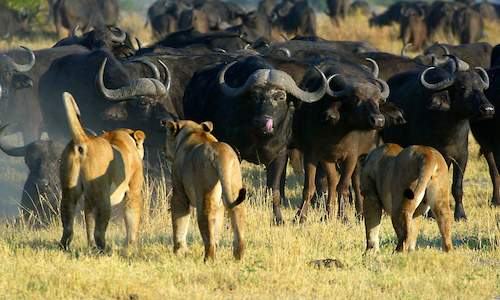
By Leigh Kemp
Animals employ a number of methods in looking out for danger, allowing them to be constantly on guard against predation. Sight, hearing and smell are all used in the survival game and animals have adapted to their surroundings according to the habitat.
When observing antelope in a group, there seems to be a constant alertness, with one or more scanning the bush and listening for sounds at any given time. An alarm call is issued at any inkling of danger.
With an alarm call other animals in the group or area will be vigilant ensuring a greater area is covered in looking for the danger. Wildlife guides will listen for the sound of alarm calls as a sign of the presence of predators.
Suricates (Meerkats) will stand on raised places such as termite mounds and logs to search the area for danger. In a group there will, at all times, be a member of the group looking in each direction while the others are foraging or grooming. Those on lookout will give an alarm call if danger is spotted. Alarm calls vary from high pitched screams to gruff barks in the different species.Fleeing from Danger
Animals employ different techniques to avoid capture when chased by a predator. Impala will flee in all directions, confusing the chasing predator, while Waterbuck and Lechwe will head for the nearest body of water. The Gazelles of East Africa and the Springbok of southern Africa use speed and the ability to change direction at full speed to evade capture.
Warthogs, Suricates and Ground Squirrels will head for their burrows, while Zebra stick close together when they are fleeing. The mass of stripes shows a much larger surface area to the predator. Oryx are known to back up against a thorny bush or tree so as to only have one direction to protect which it does with its rapier like horns.
Some animals are known to back up against safari vehicles when been chased by predators. I have observed a Wildebeest using a safari vehicle to fend off Wild Dogs. This technique allows the prey animal to defend only one flank and thereby give it a better chance of survival.
The debate is whether this is a new behaviour learnt since the advent of game drives. Prey species have been observed using barriers such as bushes to defend themselves so it can be deduced that the behaviour is not new, only that the vehicles are a new barrier.
Firing back Against Predators
Porcupines have dangerous quills that have caused the death of many predators.
The quills on the porcupine lie flat when it is moving but at the first sign of danger it will raise the quills and rattle the hollow ones at the end of its tail. If this does not drive the intruder away then the Porcupine will back into the danger and if the intruder still does not move away it will be impaled with the sharp quills.
The quills have a barb at the end that makes it difficult to pull them out. Lions and Leopards have died from quills that are embedded in the mouth when the quills render them unable to eat.

 Inter-species dominance comes into play when food is scarce. This Botswana Wildlife Guide tells of Giraffes fighting back and an interaction...
Inter-species dominance comes into play when food is scarce. This Botswana Wildlife Guide tells of Giraffes fighting back and an interaction...